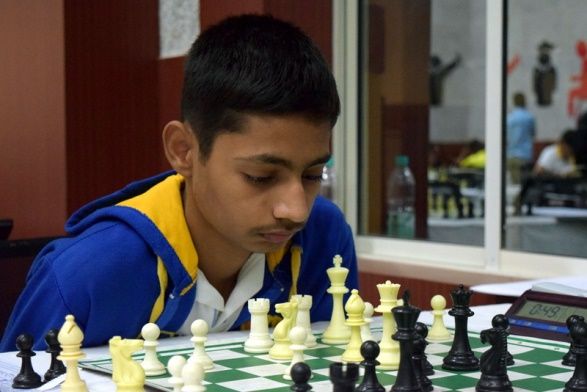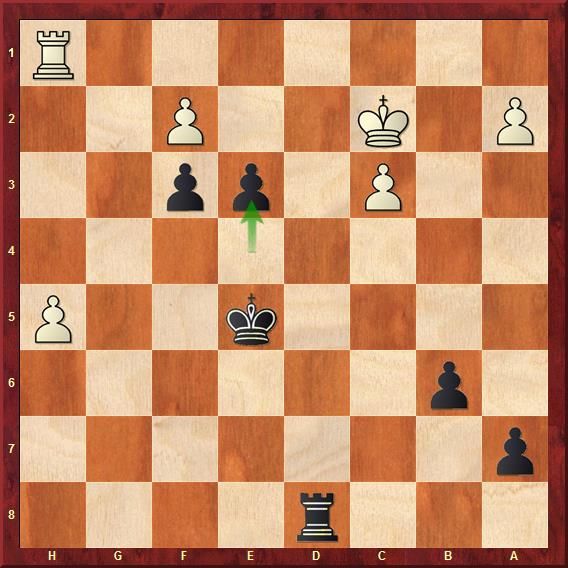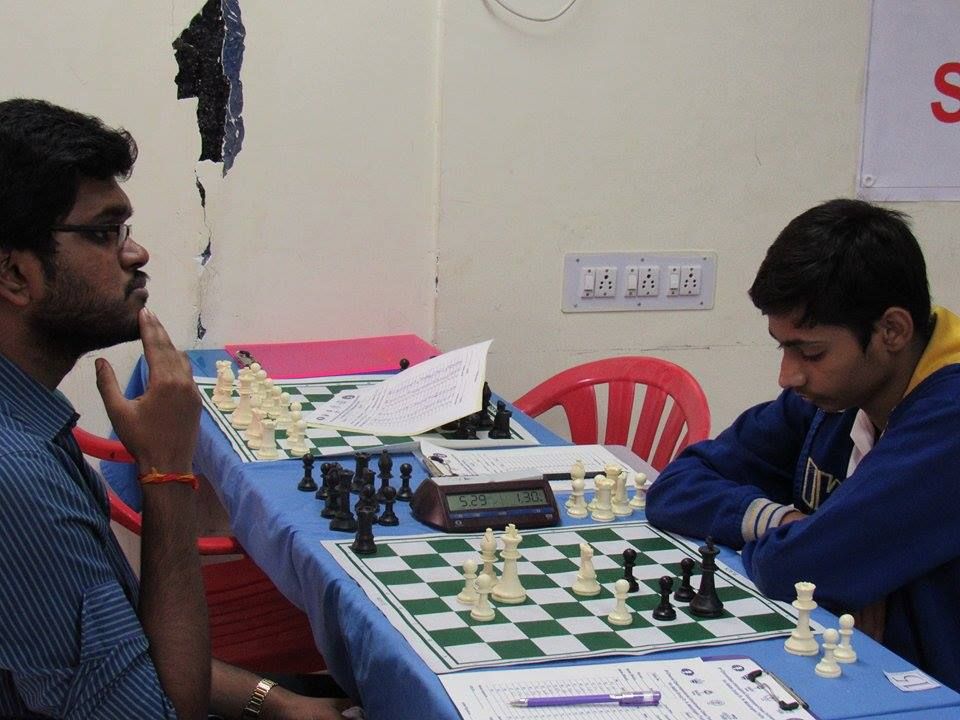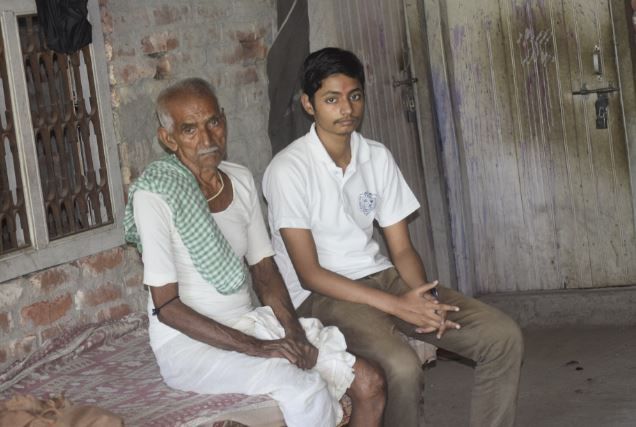Bihar's First Grandmaster
Bihar never had a grandmaster of its own. In fact, it still does not have any. We had reported some weeks back that 16-year-old Kumar Gaurav had become the Indian Junior Chess Champion despite starting as the 42nd seed. Almost all the winners of the Indian Junior Championships in the past 15 years have become strong Grandmasters today. Most notable are Viswanathan Anand, Pentala Harikrishna, Abhijeet Gupta, and more. But Gaurav will never become a grandmaster without our help! Let us help him become the first grandmaster from Bihar!
Bihar's First Grandmaster

The penultimate round of the Indian Junior Chess Championship 2016 was in progress in Rajahmundry, Andhra Pradesh. The Open section looked like a tense affair, and many players and spectators were glued to the game on the first board. The 42nd seed Kumar Gaurav of Bihar was leading the event and had a critical decision to make. His opponent Shailesh Dravid’s eyes were darting back and forth the board and his opponent’s eyes. He was trying to figure out where Kumar was looking. Chess players do that — it helps us to understand what the opponent is planning to do next.
Gaurav found the move. His heart pounded hard telling him that this move will win; his body was feeling the pressure. Not his brain, though. His brain stood detached from the rest of his body, calculating one variation after another at breakneck speed. Gaurav stretched his hand forward, but before he could touch the black pawn and move, he paused.
One right move and he becomes India’s Junior (Under-19) champion, joining the likes of Viswanathan Anand (five-time world champion), Pentala Harikrishna (India No. 2), who had won it previously. Gaurav, young and hopeful, was one move away from entering the fast track to greatness. However, he paused not because of that. He froze because he knew that one wrong move here and he could become a forgotten nobody.


It is this innate ability to calculate accurately that makes Gaurav a talent to watch out for. However, the problem has always been the same for him — shortage of finance.
Vishal Sareen has coached numerous big names in his career. He has nurtured young talents like Abhijeet Gupta, Sahaj Grover, Tania Sachdev, and more to grandmaster status. He is also the coach of the Indian women's team. He has been coaching Gaurav for a couple of years now and is confident of his ward's ability.
Vishal explains, "I hope the Junior title will provide that impetus that takes him to higher laurels. What he needs is support. He needs international exposure; he needs to think about learning, not about the fact that there is no money at home. When there is any pressure on any child it's very difficult to get results."
Vishal continues: "In the recent past he has studied a lot. He has sorted his openings a little bit and has been working consistently. The results are still very few and far between — one IM norm and now this Junior title. I seriously feel it can be much better."

[Site "?"]
[Date "2016.01.20"]
[Round "4"]
[White "Kumar, Gaurav"]
[Black "Mohammad, Nubairshah Shaikh"]
[Result "1-0"]
[ECO "B43"]
[WhiteElo "2030"]
[BlackElo "2422"]
[Annotator "Sagar Shah"]
[PlyCount "107"]
Usually White castles before playing Qe2. So Bd6 is impossible as it is met
with f4! But Nubair sees that f4 is no longer possible and goes for this. But
Kumar has a surprise in store for him.} 8. Ndb5 $1 {This is not just a
tactical blow. White will have long term compensation.} axb5 9. Nxb5 Qa5+ 10.
Bd2 Bb4 {So the piece isn't lost.} 11. Bxb4 Qxb4+ 12. c3 Qc5 (12... Qa5 13. e5
Nd5 14. Nd6+ Kf8 15. Qh5 g6 16. Qh6+ Kg8 17. Ne8 $18 {Hence, it is important
to have the queen on c5 from where it can retreat to f8.}) 13. e5 Nd5 14. Nd6+
Kf8 15. Qh5 (15. Qf3 f5 $1 (15... f6 $2 16. Qh5 g6 17. Qh6+ Ke7 (17... Kg8 18.
Bxg6 hxg6 19. Qxg6+ Kf8 20. Qf7#) 18. Qg7+ $18) (15... Nf6 $2 16. Qf4 $18) 16.
Bxf5 Nf6 $1 17. O-O-O Qxe5 $15) 15... g6 16. Qh6+ Kg8 17. O-O (17. Ne8 Qf8 $19)
17... Nc6 {The pawn on e5 is hanging and it is not so easy to defend it. Rfe1
is anyway met with Nxe5 as the d6 knight would be hanging.} (17... Ne7 18. Ne8
$18) 18. Qg5 (18. b4 $5 Qxc3 19. Ne8 (19. f4 $1 Nxe5 (19... Qxd3 20. Ne8 $18)
20. fxe5 Qxe5 21. Rxf7 Qxa1+ 22. Bf1 $18) 19... Qxe5 20. Rae1 Qd4 (20... Qc3
21. Rc1 Qd4 22. Rc4 Qb2 23. Rb1 Qe5 24. f4) 21. Re4 Qc3 22. Rc4 Qb2 23. Rb1 Qe5
24. Re4 Qc3 25. Rc4 $11 Qe5 26. f4 Nxf4 27. Rxf4 f5 $11 {And somehow Black is
clinging on. But seeing Black's under developed pieces, I am sure there is
some way for White to win.}) 18... h6 19. Qg3 Nde7 (19... Nf4 $1 {was an
excellent defence not at all easy to find.} 20. Qxf4 Nxe5 21. Rfe1 (21. Rae1 $2
Qxd6 22. Bb5 (22. Rxe5 Qxd3 $19) 22... Rxa2 $17) 21... Qxd6 22. Bb5 g5 23. Qxe5
Qxe5 24. Rxe5 d5 $11) 20. Rfe1 Nf5 21. Bxf5 exf5 22. Nxf5 d5 $2 {It was
important, not to lose control of the e6 square.} (22... Qc4 $1 {And although
Black's position looks dangerous, he is clinging on.}) (22... Kh7 {was also a
possibility.}) 23. e6 $1 {Kumar is sharp and doesn't miss the opportunity.}
Bxe6 (23... Kh7 {is the critical test of the move.} 24. b4 $1 {The queen has
to be deflected from the control of f8.} (24. Nh4 Qe7 $17) 24... Qb6 (24... Qc4
25. Nd6 $18) 25. Qf4 $3 {I wonder if Kumar would have been able to find this
move. Maybe not so difficult, but surely such moves are not so easy to see
from far.} (25. Nh4 Nd8 $1 $17) 25... g5 (25... gxf5 26. Qxf5+ Kg7 27. Qxf7#)
26. Qf3 $1 Bxe6 27. Qh5 $1 $18 Kg8 28. Rxe6 fxe6 29. Qg6+ $18) 24. Rxe6 {
White is a pawn up, has a safer king, the rest is just easy.} Rh7 (24... fxe6
25. Qxg6+ Kf8 26. Qg7+ Ke8 27. Qxh8+ Kd7 28. Qxa8 exf5 29. Qxb7+ $18) (24...
Kh7 25. Rxg6 (25. Qf4 gxf5 26. Rxh6+ Kg7 27. Qg5+ Kf8 28. Rxh8#) 25... fxg6 26.
Qc7+ $18) (24... Kf8 25. Rxg6 fxg6 26. Qxg6 Rg8 27. Qf6+ Ke8 28. Re1+ Kd7 29.
Qf7+ Ne7 30. Rxe7+ Kc6 31. Rc7+ $18) 25. Ree1 (25. Rae1 $1 fxe6 26. Qxg6+ Kh8
27. Qf6+ Kg8 28. Qxe6+ Kh8 29. Qf6+ Kg8 30. Qg6+ (30. Re3 $18) 30... Kh8 31.
Re8+ Rxe8 32. Qxe8+ $18) 25... d4 26. Nxd4 Nxd4 27. cxd4 Qxd4 28. Qb3 Kg7 29.
Re7 Qf6 30. Rxb7 Rhh8 {White took the pragmatic decision and is two pawns up,
but I didn't like his next move.} 31. Qc3 $6 Rhc8 $2 (31... Qxc3 32. bxc3 $16 {
I have a feeling that Black has the best chances in this position. White will
most probably lose a pawn and then he has to win in a 4 vs 3 endgame, where he
has to be extremely accurate.}) 32. Qxf6+ Kxf6 {With the connected pawns it
much easier to win now.} 33. g3 Rc2 34. a4 Rd8 35. a5 Rdd2 36. a6 $1 {
Tactically Kumar is always alert!} Rxf2 (36... Kg7 37. a7 Rxf2 38. Rxf7+ Kxf7
39. a8=Q $18) 37. Rf1 Rxf1+ 38. Kxf1 Rxh2 39. a7 (39. Rb3 Rh1+ 40. Kg2 Ra1 41.
Ra3) 39... Rh1+ 40. Kg2 Ra1 41. b4 Ke5 42. b5 (42. Rb5+ Kd4 43. Ra5 $18) 42...
Ra2+ 43. Kf3 f5 44. b6 Ra3+ 45. Ke2 Ra2+ 46. Kd1 Kd4 47. Rb8 Kc5 48. a8=Q Rxa8
49. Rxa8 Kxb6 50. Rg8 g5 51. Rg6+ Kc5 52. Rxh6 Kd4 53. Re6 Kd5 54. Re8 {
A fine game, and I especially liked the part where White was a piece down, but
played as if nothing really happened.} 1-0

To give you an idea how brilliant Gaurav can be, despite all the pressure he has to suffer under, have a look at another smooth win:
[Site "?"]
[Date "2015.06.06"]
[Round "7"]
[White "Kumar, Gaurav"]
[Black "Sammed , Jaykumar Shete"]
[Result "1-0"]
[ECO "B19"]
[WhiteElo "2197"]
[BlackElo "2071"]
[Annotator "Sagar Shah"]
[PlyCount "59"]
possible manner, Kumar's finish was flawless.} 1. e4 c6 2. d4 d5 3. Nc3 dxe4 4.
Nxe4 Bf5 5. Ng3 Bg6 6. h4 h6 7. Nf3 Nd7 8. h5 Bh7 9. Bd3 Bxd3 10. Qxd3 e6 11.
Bd2 Ngf6 12. O-O-O Be7 13. Kb1 O-O {The main line of Caro Kann these days
where hundreds of games have been played. Nothing much to speak about, but for
attacking players with white pieces, this is quite a nice position to play.
You get the knight out of g3 and push your pawn down the board g4-g5, and
checkmate the black king. You think I am joking? Look what happened in the
game!} 14. Ne4 c5 15. g4 $1 {It's now or never. Structurally Black is fine.
Hence, you cannot wait too long.} Nxg4 16. Qe2 Ngf6 $2 {To put it simply, this
move cages down the Black king. He needs to push the f-pawn in order to have
some breathing space. Be it with Rf7 or bringing the knight back to f6.With
the pawn on f7, this is just going to be a carnage.} 17. Nxc5 Nxc5 18. dxc5 Qc7
19. Rhg1 Kh8 20. Ne5 Qxc5 (20... Bxc5 {The computer thinks that this is a
better move. Maybe it is, but Black has to find loads of accurate moves in
order to survive and even then it might not be easy. For eg.} 21. Bc3 Rad8 22.
Rxg7 Kxg7 23. Ng4 Rxd1+ 24. Qxd1 Be7 25. Nxf6 Bxf6 26. Qg4+ $18) 21. Bc3 Qc7 $2
{This was the critical mistake. Of course, Black could have played better but
White would have retained his attacking chances. Here, it's just over.} (21...
Nd5 22. Bd4) 22. Rxg7 $1 (22. Nd7 {is strong, but nowhere near what happened
in the game.}) 22... Kxg7 23. Rg1+ Kh7 24. Qd3+ Ne4 (24... Kh8 25. Ng6+ fxg6
26. Qxg6 $18) 25. Nxf7 $1 {Accuracy right until the very end!} Rxf7 26. Qxe4+
Rf5 27. Rg7+ Kh8 28. Rxe7+ Qxc3 29. bxc3 Rd8 30. Qxb7 1-0

With a serious tone, Vishal says, "Gaurav is an extreme example of sports in India. How can we expect them to progress with so much financial burden upon them? I hope time does not run out before he achieves his true potential."
What is his 'true potential'? Vishal: 'Grandmaster. At the least. Itna to ban hi jayega.' (He will surely become one.)
Vishal must know what it takes. Now, it is our responsibility to help him grow as a player. When we asked him what tournaments Gaurav should ideally be playing for better exposure, Vishal pencil-marked Hastings Open, Cannes Open in February, Dubai Open and Reykjavik Open in April as the events he would like to aim for.
(Please turn on the subtitles and captions by clicking on the Settings.)
We request you to transfer your sponsorship to the following account:
A/c holder Name: KUMAR GAURAV, S/O DEONANDAN YADAV
Bank Name: BANK OF BARODA
Branch Name: ARARIA, BIHAR Pin: 854311
Type of account: SAVINGS ACCOUNT
Account Number: 30420100008633
IFSC Code: BARBOARARIA
MICR Code: 854012002
Related:
- Searching for a better life with Chess
- National Juniors: Champion is traveling back with an unreserved ticket
- Gaurav's first IM norm
Download games of Kumar Gaurav deeply annotated by IM Sagar Shah
